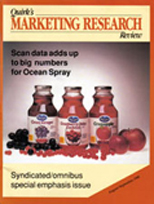Since the advent of supermarket scanning data, these industry officials can now go beyond that and find out the answer to the question, "What's driving my business?"
Having access to this information has made many of these people happy and Information Resources, Inc., an equally proud supplier of such data.
The Chicago-based IRI has provided a scanning data service since 1986 when it launched InfoScan™ . InfoScan provides insight into a brand's performance and the consumer behavior behind that performance. It does this by tracking consumer purchasing for every UPC-coded product sold in supermarkets across the country, together with all the promotional activities - price reductions, retailer newspaper ads, couponing and in-store displays - that motivate purchasing. As a result, InfoScan provides its clients' sales and marketing departments with scanner- based weekly measurements of volume, market share, price and promotional conditions, item-by-item, week-by-week and city-by-city. Approximately 2,400 stores in 76 markets are part of IRI's sample. In addition, InfoScan integrates this scanner database with the individual purchases of more than 70,000 representative households. Using UPC scanners, everything these consumers buy is recorded.
The representative households are what make up IRI's consumer panel. The panelists can shop at any store and merely present an ID card to the cashier upon check-out. All of their purchases, even in drug stores, are electronically recorded and individually tracked. The panel reflects total market behavior and provides for the analysis of trial and repeat, buying rate, loyalty, purchase cycles, brand shifting, demographics and other issues concerning purchasers' behavior.
Ocean Spray
Ocean Spray Cranberries, Inc., Plymouth, Mass., has been an IRI and A.C. Nielsen Co. scanning data user for several years. John Tarsa, manager, marketing research at Ocean Spray, says the key to IRI's system is its "ability to identify and measure the conditions and marketing mix at key stores. The store level data allows for greater sensitivity in modeling applications," says Tarsal The company gets weekly scanning data from both IRI and Nielsen. The information is on data tapes which is loaded onto Ocean Spray's mainframe computer. "This computer is devoted entirely to this type of data," says Tarsal.
Ocean Spray also makes use of IRI's PromotionScan™ . This syndicated service allows the company to clearly measure the sales increase generated by each of its promotional events, such as newspaper ads, in-store displays, price reductions and coupon distributions.
PromotionScan capitalizes on a major trend in the consumer packaged goods industry: a shift occurring in promotion vs. advertising spending. The consumer packaged goods industry spends billions a year on promotion. Consider couponing, for example. Almost 200 billion coupons were distributed in 1986, a doubling over the level in 1981. With an average coupon face value of 27 cents, the industry incurs about $2 billion each year the cost of distributing those coupons.
Impact on sales
PromotionScan uses the capabilities of IRI's proprietary mathematical models and detailed store sales and household purchase data in InfoScan to measure the impact of promotions on sales. With PromotionScan, a manufacturer can also measure the impact of every promotional event on each brand's consumer franchise, i.e., actually measure an increase or decrease in brand loyalty based on real consumers and their actual shopping patterns over time.
By identifying which promotions work best, PromotionScan can save IRI clients tens of millions of dollars and help clients protect their most valuable resource, their brand names. While Tarsa says his company is delighted with data it gets through scanning, he describes it as "massive."
Obtaining information
"Every week, several million numbers are new to the database. We must be able to take that data and turn it into information that the brand manager can use. What we're dealing with now is translating those numbers into information."
Continues Tarsa, "this challenge requires people who have a blend of skills: marketing research, marketing and systems knowledge. People who can deal with data, anticipate marketing needs and develop systems to deliver that information are highly desirable."
But managing the data "is going to be painful," admits Tarsa, and "it's causing some strain on the organization and upheaval in the organizational structure. "We don't have all the answers. But we think our culture and this will allow us to get the data out in a timely and usable fashion and importantly, ahead of competition."
